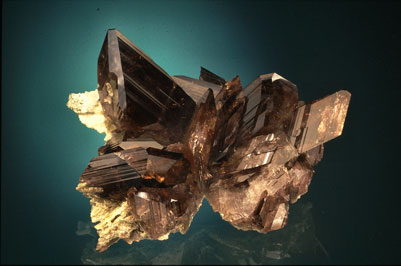| Crystal system | Triclinic |
| Transparency | Transparent to translucent |
| Luster | Vitreous |
| Fracture | Conchoidal |
| Cleavage | Distinct pinacoidal |
| Specific Gravity | 3.29 |
| Hardness | 6.5 to 7 |
| Optical Character | Biaxial - ; Double Refractive |
| Refractive index | 1.678-1.688 |
| Birefringence | 0.10 |
| Dispersion | |
| Fluorescence | inert; yellow stones may fluoresce red |
| Pleochroism | Strong; Pale green, violet-blue & reddish- brown |
| Chemical Formula | |
| Comments | |
| Streak | |
This rare mineral (pronounced AK-sin-ite), a complex hydrous calcium aluminum borosilicate that occurs in purplish-brown, brownish-yellow and violetish-blue colors, is sometimes cut for collectors. Light gray crystals also occur. The name is from the Greek word meaning "axe", in allusion to the axe like or wedge-shaped triclinic crystals in which it occurs.
The pleasing colors of axinite are enhanced by its strong pleochroism, the three colors being pale green, violet-blue and reddish-brown. It is biaxial negative, has a distinct cleavage, fractures easily, and has a hardness of 6 1/2 to 7. The R.I. is approximately 1.678 - 1.688, with a birefringence near .010, and the S.G. is about 3.29. The luster is vitreous. It is not attacked by acids but fuses easily. With the exception of the brownish-yellow variety, the other colors of axinite are distinctive. Of the stones that may resemble it in appearance, chrysoberyl and hessonite garnet are appreciably higher in R.I.; topaz and tourmaline are lower.
Axinite is formed as the result of the action of molten igneous
material on pre-existing limestones. Fine material has come from the
French Alps and Tasmania. Other localities include Cornwall,
England; near Ottawa, Canada; Pennsylvania; U.S.A..
Attractive
stones may be cut from axinite by using crown angles of 43°,
pavilion angles of 39°, and polishing on a lucite lap with cerium
oxide.
The rarity, lack of a distinctive color and relative fragility of axinite limit its interest to collectors.


